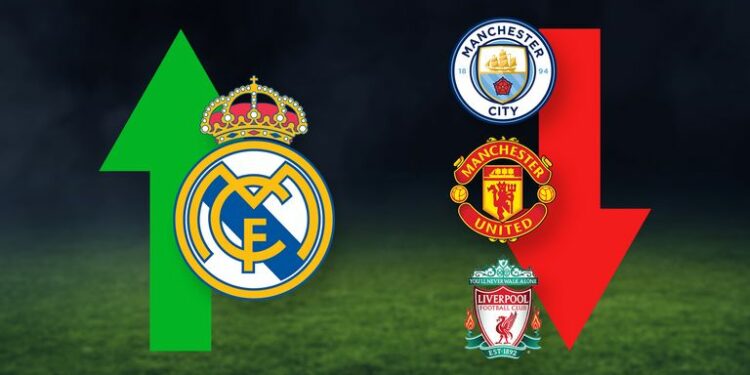Deloitte Football Money League: Real Madrid returns to the top as matchday and commercial revenues surge across Europe
Real Madrid have knocked Manchester City off the top spot of the Money League to become the highest revenue generating football club in 2022/23.
They return to the top for the first time since 2017/18 with reported record revenue of €831m, an increase of €118m over the previous year. The club’s growth is largely attributable to strong retail performance and higher stadium attendance.
Manchester City fall to second place in the 2024 ranking despite a record-breaking 2022/23 season both on and off the pitch. The club reported its highest ever revenue for a season, €826m, driven by successful UEFA Champions League and Premier League campaigns that bolstered both broadcast and commercial revenues by €50m and €26m respectively.
Elsewhere, Paris Saint-Germain broke into the top three for the first time in Money League history with revenues of €802m. FC Barcelona in fourth position (€800m) are one of the biggest movers in this year’s Money League, rising from 7th place as a result of club record licensing and merchandising revenues and fans returning to stadia.
Liverpool (€683m) reported the greatest fall in year-on-year rankings, moving from third to seventh due to a downturn in on-pitch results across both domestic and European competitions. Liverpool were one of three Money League clubs (alongside Atlético de Madrid and West Ham United) to report a decline in revenue.
While there were minimal changes year-on-year to the top 10, there have been notable changes between positions 11-20. Teams from continental Europe; Eintracht Frankfurt, SCC Napoli and Olympique de Marseille replace a trio of English clubs in Leicester City, Leeds United and Everton, demonstrating the influence of on-pitch performance on financial revenues. In the 2022/23 season, the number of Premier League clubs in the Money League has fallen to eight after at least 10 clubs featured in the past two years.
Bridge added: “In the coming seasons, European clubs may look to further diversify their revenues in order to gain control over a larger proportion of their total revenue. This will enable clubs to not only protect themselves from the variability of on-pitch performance, but also wider challenging macroeconomic conditions and changes to the football system. At a time when clubs face a greater degree of financial regulation, striking the right balance between securing the best on-pitch talent with sustaining a sound financial foundation through commercial activities will be key.”
Top ranked women’s clubs across Europe average revenues of €4.3 million
This edition of the Money League includes analysis of 15 of the highest revenue generating women’s clubs in European football.*
FC Barcelona Femení remained at the summit of women’s football in Europe in the 2022/23 season, reporting €13.4m in revenue, a year-on-year increase of 74%.
Manchester United Women also retained their position in second place, with revenues of €8m, driven by a strong commercial performance (€6m). Meanwhile, Real Madrid Femenino rose to third place as it reported €7.4m in revenue, an increase of 416% over previous year.
Manchester City Women (€5.3m) take fourth position with a year-on-year revenue increase of 5%, one of only three clubs (alongside Paris Saint-Germain Féminine and Everton Women) in the top 15 to report less than double-digit revenue growth. Arsenal Women complete the top five with revenue of €5.3m, a 138% increase year-on-year. The club achieved the highest matchday revenue amongst the 15 clubs (€3.1m, 58% of its total revenue), having hosted three of the clubs’ WSL games in 2022/23 at Emirates Stadium, each drawing attendances of over 40,000.
Of the 15 women’s clubs included in Deloitte’s analysis, the average revenue stood at €4.3m, a 61% increase over their 2021/22 average (€2.6m).Within this, commercial revenue accounted for 58% of the 14 clubs’ total revenue, followed by matchday 22% and broadcast 20%. **
However, the findings highlight that there is significant diversity in the way that clubs generate revenue, even within the same league. Manchester United Women for instance generated 74% of its revenue through commercial partnerships, while Arsenal Women earned 58% of its revenue from matchday income.
Broadcast revenue across each league also varies greatly. England’s WSL and Spain’s Liga F had annual broadcast rights values of c.€8m in 2022/23, approximately eight times that of Italy’s Serie A Femminile (c.€1m), which became fully professional from the 2022/23 season.
Amy Clarke, women’s sport lead in Deloitte’s Sports Business Group, commented: “Significant levels of financial growth were recorded in the 2022/23 season across the top-tiers of European women’s football. A rise in the number of women’s matches playing at clubs’ main stadia boosted matchday revenues, while increased viewership and individual partnerships helped to accelerate the commercialisation of the game.
“Women’s football is beginning to tell the tale of growth, but that growth is not confined by a single business model. Each club is exploring its own unique way to maximise revenues within the current structure of the game.
“Given that the women’s game within the mainstream is at a formative stage, there is a real opportunity to define the sport globally through innovative thinking across all aspects of the game, including player welfare, commercial relationships, governance and business models.”








